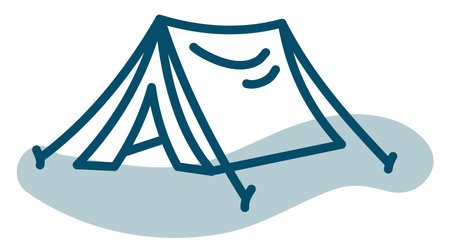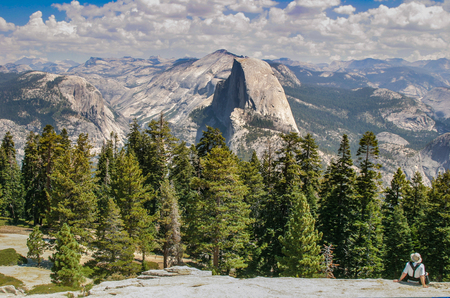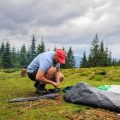Respecting Wildlife Boundaries
When visiting Americas national parks, one of the most important rules for ethical wildlife photography is to respect the space of the animals. Wild animals aren’t used to human interaction, and getting too close can stress them out or even put both you and the animal in danger.
Keep Your Distance
Always stay a safe distance away from wildlife. The National Park Service recommends staying at least 100 yards (about the length of a football field) from predators like bears and wolves, and 25 yards from other animals like elk, bison, or deer. It might be tempting to get closer for that perfect shot, but using a zoom lens allows you to capture detailed images without putting anyone at risk.
Recommended Minimum Distances
| Animal Type | Minimum Distance |
|---|---|
| Bears & Wolves | 100 yards (91 meters) |
| Bison, Elk, Deer | 25 yards (23 meters) |
Use the Right Equipment
A good zoom lens is your best friend in wildlife photography. Look for lenses with at least 200mm focal length or more so you can keep your distance and still get that close-up shot. Tripods or monopods also help stabilize your camera when youre zoomed in from far away.
Watch for Signs of Stress
Animals will often show signs when they’re feeling uncomfortable or threatened. Here are a few common signs to look out for:
| Animal Behavior | What It Might Mean |
|---|---|
| Pacing or restlessness | The animal is anxious or trying to escape |
| Ears back, raised tail, or stomping | The animal feels threatened and may charge |
| Vocalizing or sudden movements | The animal is warning you to back off |
If you notice any of these behaviors, its time to step back and give the animal more space. Respecting these boundaries helps keep wildlife wild—and keeps everyone safe.
2. Sticking to Designated Trails and Viewpoints
When youre out capturing stunning shots of wildlife in America’s national parks, its important to remember that the park’s rules aren’t just suggestions—theyre there to protect both you and the environment. One of the most essential rules for ethical wildlife photography is staying on marked trails and using designated observation areas.
Wandering off-trail might seem like a great way to get a unique shot, but doing so can damage fragile ecosystems, disturb animal habitats, and even put you at risk. Animals may flee, abandon their young, or become stressed by unexpected human presence. Plus, trampling native plants can lead to long-term harm that affects not just the scenery but also the food sources for local wildlife.
Why Staying on Trails Matters
| Reason | Impact |
|---|---|
| Protects Wildlife Habitat | Prevents disruption to animals’ natural behaviors and nesting areas. |
| Preserves Native Vegetation | Keeps rare or delicate plant species from being trampled or destroyed. |
| Reduces Erosion | Minimizes soil damage and trail widening caused by off-trail walking. |
| Keeps You Safe | Avoids dangerous terrain and potential encounters with aggressive wildlife. |
Use Established Viewpoints for Photography
Many parks offer designated viewpoints specifically designed for safe and respectful wildlife observation. These spots are chosen because they offer great sightlines while minimizing your impact on the environment. Theyre often elevated or set back just far enough to let you photograph animals without disrupting them.
Pro Tip:
If youre patient and quiet, animals are more likely to appear naturally near established viewing areas. A zoom lens will help you get that perfect close-up without needing to move closer than you should.
Remember:
Just because no one is watching doesn’t mean it’s okay to break the rules. Respecting trails and viewpoints means respecting nature—and that’s what ethical wildlife photography is all about.

3. Avoiding Baiting or Disturbing Animals
One of the most important rules in ethical wildlife photography is to never feed or lure animals just to get a better shot. While it might seem harmless or even helpful, feeding wildlife can lead to serious consequences for both the animals and humans.
Why Feeding or Luring Wildlife Is Harmful
When animals become accustomed to being fed by people, they start associating humans with food. This can lead to aggressive behavior, dependency on human handouts, and even relocation or euthanasia if the animal becomes a threat. Additionally, unnatural food can make animals sick or disrupt their diet.
Common Problems Caused by Feeding Wildlife
| Problem | Description |
|---|---|
| Habituation | Animals lose their natural fear of humans, which can make them more vulnerable. |
| Aggressive Behavior | Wildlife may approach people expecting food and act aggressively when they don’t get it. |
| Poor Nutrition | Human food often lacks the nutrients animals need and can lead to illness or death. |
| Disrupted Natural Behavior | Baiting can change how animals hunt, forage, or migrate—distorting their natural habits. |
How Ethical Photographers Capture Authentic Moments
The best wildlife photographers rely on patience and observation. Instead of trying to control the scene, they learn about animal behavior and use tools like long lenses to capture incredible moments from a safe distance.
Tips for Responsible Wildlife Photography:
- Use a telephoto lens: This allows you to stay far enough away while still getting great shots.
- Stay quiet and still: Move slowly and avoid sudden movements that could startle wildlife.
- Know your subject: Research the species you want to photograph so you understand its habits and needs.
- Avoid nesting areas: Getting too close during breeding season can cause parents to abandon nests.
By respecting nature and avoiding actions that disturb wildlife, photographers help preserve the wild spirit of Americas national parks for everyone to enjoy—now and in the future.
4. Using Appropriate Gear and Techniques
When it comes to ethical wildlife photography in American national parks, using the right gear can make a big difference. The goal is to capture stunning images without disturbing animals or damaging their natural habitat. Let’s take a look at the essential equipment and techniques that help promote responsible photography in the wild.
Recommended Gear for Ethical Wildlife Photography
Choosing gear that allows you to keep your distance from animals while still getting high-quality shots is key. Here are some essentials:
| Equipment | Purpose | Ethical Benefit |
|---|---|---|
| Telephoto Lens (300mm+) | Capture close-up shots from a safe distance | Keeps you from approaching wildlife too closely |
| Tripod or Monopod | Stabilize your camera for sharp images | Reduces need for repositioning or sudden movements |
| Silent Shutter Mode | Takes photos quietly without loud clicks | Avoids startling or stressing animals |
| Weather Protection (Lens Hood, Rain Cover) | Protect gear in outdoor conditions | Prevents accidents that could disrupt wildlife areas |
Techniques That Respect Wildlife
Besides having the right gear, how you use it matters just as much. Here are a few best practices when photographing wildlife ethically:
- Stay on designated trails: Avoid stepping off paths to get closer; this protects both animals and fragile habitats.
- Use long lenses instead of zooming with your feet: This keeps wildlife comfortable and safe.
- Shoot in burst mode sparingly: Continuous shutter sounds may stress animals—only use it when necessary.
- Avoid using flash: It can startle animals and affect their behavior, especially nocturnal species.
- Learn animal behavior cues: Recognizing signs of stress helps you know when to back off and give them space.
The Bottom Line on Equipment Choice
Your gear should work for the animals—not just for you. By investing in tools that allow you to shoot from afar, minimize noise, and respect the environment, youre helping preserve the natural experience for both wildlife and future visitors. Responsible photography starts with thoughtful preparation—and that begins with what you carry in your pack.
5. Understanding and Following Park Regulations
Before heading out with your camera gear, it’s important to understand that every national park in the U.S. operates under its own set of rules and guidelines. What’s allowed in one park might be restricted in another. Taking time to familiarize yourself with these specific regulations helps ensure you’re not only following the law but also protecting the wildlife and natural beauty you came to photograph.
Why Knowing the Rules Matters
Park regulations are designed to balance public access with the protection of sensitive environments and species. As a wildlife photographer, you have a responsibility to respect those boundaries. Whether youre a hobbyist or a professional, understanding and complying with park policies shows respect for nature and helps preserve it for future generations.
Key Areas to Check Before Your Visit
Each national park may have different requirements depending on its location, wildlife population, and visitor traffic. Here are some common areas you should research before visiting:
| Regulation Area | What to Look For |
|---|---|
| Drone Usage | Most national parks prohibit drones due to their impact on wildlife and other visitors. Check if any exceptions apply or if special permits are available. |
| Photography Permits | If youre shooting commercially or using large equipment, you may need a special use permit. Always verify with the parks official website. |
| Restricted Areas | Some trails or zones may be off-limits during nesting seasons or due to habitat restoration efforts. Maps and ranger stations usually provide updates. |
Helpful Tip:
Visit the official National Park Service (NPS) website for the specific park youre visiting. They often have downloadable PDFs, alerts, and ranger contact information so you can plan ahead responsibly.
Remember:
Following the rules doesn’t limit your experience — it enhances it by keeping wildlife safe and ensuring others can enjoy these spaces too.
6. Sharing Responsibly on Social Media
Social media is a powerful tool for sharing the beauty of wildlife photography, but it also comes with responsibility. How you present your images online can influence others behavior and impact the well-being of animals and their habitats in American national parks.
Why Responsible Sharing Matters
When people see stunning wildlife shots, they often want to recreate them. If those photos were taken too close to animals or in sensitive areas, it may unintentionally encourage harmful behavior. Ethical sharing helps protect wildlife by promoting respectful and safe practices.
Best Practices for Captioning Wildlife Photos
What you write in your caption matters just as much as the image itself. Use captions to educate and inspire conservation-friendly actions.
| Dos | Donts |
|---|---|
| Mention using a zoom lens to capture the photo from a safe distance. | Avoid implying that you got close to the animal for a better shot. |
| Include facts about the species or its habitat to raise awareness. | Don’t use emojis or language that humanizes wild animals (like “he smiled at me”). |
| Use hashtags that promote ethical photography like #KeepWildlifeWild or #EthicalWildlifePhotography. | Avoid tagging exact GPS locations, especially for rare or vulnerable species. |
Using Location Tags Wisely
While its tempting to tag the exact spot where you captured a great shot, doing so can lead to overcrowding and stress for wildlife. Instead:
- Tag general areas like “Yellowstone National Park” instead of specific trails or viewpoints.
- If youre sharing sensitive content, consider not tagging any location at all.
Lead by Example
Your followers may look up to your work. By showing respect for wildlife through your photos and captions, you set a positive example for others. Always aim to inspire admiration for animals without encouraging interference with their natural behaviors.
Remember:
The goal of ethical wildlife photography isnt just getting a great shot—its protecting what makes those moments possible in the first place: wild animals living freely in their natural environment.


